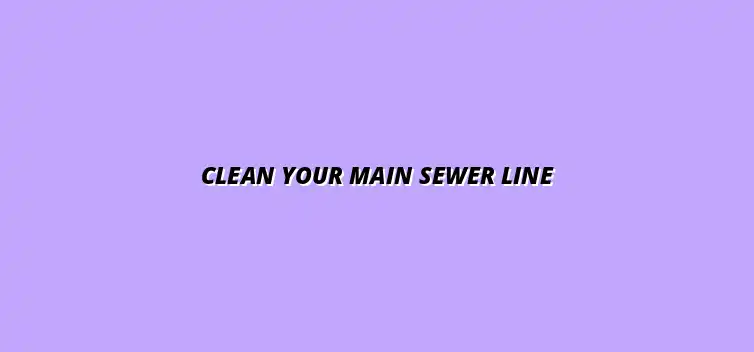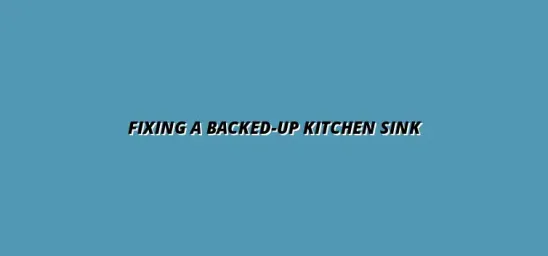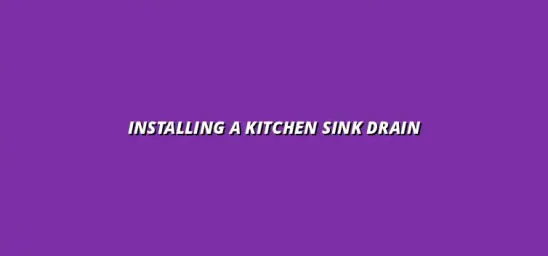
Clean Your Main Sewer Line
Understanding the Importance of Main Sewer Line Maintenance
Keeping your home's main sewer line in good shape is critical for many reasons. It helps prevent major plumbing issues that can disrupt your daily life and cause costly repairs. Regular maintenance ensures that everything flows smoothly, protecting both your home and your wallet!
By paying attention to your sewer line, you're not just maintaining pipes underground; you're also ensuring the health and safety of your family. A well-maintained sewer line can save you from nasty backups and unpleasant odors, leading to a more comfortable living environment. Regular drain cleaning is key to this, offering many regular drain cleaning benefits.
Why Cleaning Your Home's Main Sewer Line is Essential
So, why should you prioritize cleaning your main sewer line? The answer lies in the consequences of neglect. Cleaning your sewer line is essential for preventing blockages that can lead to serious plumbing problems. Knowing when to clean your pipes is a crucial first step.
- Prevents Backups: Regular cleaning keeps your sewage flowing, avoiding unpleasant backups in your home.
- Reduces Odors: A clean line helps eliminate foul smells that can come from a clogged sewer.
- Extends Lifespan: Proper maintenance can prolong the life of your plumbing system, saving you money in the long run.
The Impact of a Clogged Sewer Line on Your Home
A clogged sewer line can lead to a host of problems, impacting your home’s overall function. It can cause water to back up into sinks, toilets, and tubs, creating a mess that can be expensive to clean up. Moreover, it can lead to structural damage if water seeps into the foundation. A clogged kitchen sink, for example, can be a major inconvenience, but thankfully, fixing a clogged kitchen sink is often manageable.
Additionally, a clogged sewer line can pose health risks due to the potential for sewage spills and contamination. Keeping your sewer line clean is a small but important task that can prevent these major headaches!
Signs Indicating Your Main Sewer Line Needs Attention
Being aware of the signs that your main sewer line needs cleaning is crucial. Early detection can save you from larger issues down the road. Here are some common indicators:
- Slow Drains: If water is draining slowly in multiple fixtures, it could signal a clog.
- Unpleasant Odors: Foul smells around drains might indicate sewage backup or a blockage.
- Water Backup: If sewage backs up into your home, it's time to act immediately!
Preparing for the Cleaning Process
Once you've identified the need for cleaning, preparing for the process is the next step. This involves gathering the right tools and supplies to ensure the job is done effectively. Having everything ready will make the task easier and more manageable! Keeping your outside drains and gutters clear is also important; find helpful tips on unclogging outside drains and gutters.
In addition to tools, it's important to prioritize safety during the cleaning process. Proper gear can protect you from potential hazards and make you feel more confident in tackling sewer line maintenance.
Gathering Necessary Tools and Supplies for Sewer Line Cleaning
Before you dive into cleaning your main sewer line, let’s discuss the tools you need. Gathering these supplies will set you up for success! Here’s a handy list of necessary tools:
- Plumber’s Snake: Essential for clearing minor clogs.
- Hydro Jet: Great for more severe blockages.
- Protective Gloves: Keep your hands safe while working.
- Drain Cleaner: Chemical options can help dissolve stubborn clogs.
Essential Equipment for DIY Sewer Line Maintenance
When it comes to equipment, having the right tools can make your job much easier! A plumber’s snake is a must-have for smaller clogs, while a hydro jet can clear more significant blockages effectively. For effective kitchen drain line cleaning, see our guide on cleaning kitchen drain lines easily.
Other helpful items to consider include a flashlight for visibility, a bucket to catch any debris, and towels for cleanup. With the right setup, you can tackle your sewer line maintenance like a pro!
Safety Gear: Protecting Yourself During the Cleaning Process
Safety should always be a priority when working with sewer lines. Be sure to equip yourself with protective gear, as this will safeguard you from potential hazards like sharp objects and harmful chemicals. Protecting your bathroom plumbing from corrosion is just as important; check out these helpful tips to prevent bathroom plumbing corrosion.
- Gloves: Use heavy-duty, waterproof gloves to keep your hands clean.
- Goggles: Protect your eyes from splashes.
- Face Mask: Avoid inhaling any unpleasant odors or fumes.
Taking these precautions will not only keep you safe but also make the cleaning process more comfortable and efficient!
Understanding Costs and Considerations
When it comes to maintaining your home's main sewer line, understanding the costs involved is vital. You have a choice between doing the cleaning yourself or hiring a professional. Each option comes with its own set of pros and cons that can affect your budget and long-term maintenance strategy. For plumbing services in Billesley, Birmingham, consider contacting a local plumber in Billesley, Birmingham.
Many homeowners are surprised to learn that while DIY cleaning may seem cheaper upfront, professional services often save you money in the long run. It’s important to weigh your options carefully, especially if you want to avoid future headaches that can arise from inadequate cleaning.
Comparing DIY vs. Professional Sewer Line Cleaning Costs
Knowing the cost differences can help you make an informed decision regarding sewer line cleaning. Here’s a quick comparison:
- DIY Costs: Equipment rental, chemicals, and safety gear can range from $50 to $200.
- Professional Costs: Hiring a plumber can cost anywhere from $150 to $500, depending on the severity of the clog and services rendered.
- Long-Term Costs: Regular professional maintenance can actually prevent costly repairs down the road.
While DIY may save you money initially, it could lead to higher expenses later if you don't clear the blockage effectively. Therefore, consider both short-term and long-term financial implications when making your choice!
Budgeting for Sewer Line Maintenance
Setting aside a budget for sewer line maintenance is an essential part of home ownership. Here are some factors to consider when budgeting:
- Routine Maintenance: Allocate funds for regular inspections and cleanings, typically needed every 1 to 2 years.
- Unexpected Repairs: Set aside emergency funds for sudden clogs or repairs that may arise.
- Equipment Costs: If you opt for DIY, factor in the cost of purchasing or renting necessary tools.
Establishing a clear budget will help you manage sewer line maintenance costs more effectively in the long run. It's key to prepare for both expected and unexpected expenses!
Evaluating Long-Term Savings vs. Immediate Costs
While the immediate cost of professional service may seem high, consider the potential savings over time. Here are some points to ponder:
- Preventing Damage: Proper maintenance reduces the risk of severe blockages and the need for costly repairs.
- Time Savings: Professionals can often complete the job faster and more effectively than a DIY attempt.
- Increased Property Value: A well-maintained sewer line can boost your home’s market appeal.
Investing in regular cleaning can lead to significant savings by preventing large-scale issues. Always keep in mind the balance between immediate costs and longer-term benefits!
Final Thoughts on Main Sewer Line Care
Caring for your main sewer line is not just about addressing problems as they arise; it’s about creating a sustainable home maintenance routine. Regular upkeep can greatly reduce the risk of serious issues down the road, saving you both time and money.
By making sewer line care a regular part of your home maintenance checklists, you ensure a healthier living environment. Let's not forget how important it is to stay proactive instead of reactive when it comes to home care!
Creating a Sustainable Home Maintenance Routine
Incorporating main sewer line care into your seasonal home maintenance routine can be incredibly beneficial. Here are some steps to consider:
- Spring Cleaning: Inspect and clean the sewer line to eliminate any debris accumulated over winter.
- Summer Check-Up: Ensure that outdoor drains and sewer line connections are clear and functioning.
- Fall Preparation: Schedule a professional inspection to prepare for the winter months.
By creating a detailed plan, you can ensure that your home remains in great shape all year round. Consistent maintenance will pay off in the long run!
Incorporating Main Sewer Line Care into Seasonal Checklists
To make maintenance easier, consider making sewer line care part of your seasonal home care checklists. Here are some essential checklist items:
- Check for slow drains or unpleasant odors.
- Inspect cleanouts and access points for blockages.
- Schedule professional inspections every 1-2 years.
When it comes to your home, staying organized can make all the difference! Keeping these tasks in mind will help you maintain your main sewer line efficiently.
Encouraging Homeowners to Take Action
Homeowners should feel empowered to take action regarding their sewer line maintenance. Understanding the importance of this task can lead to a healthier home environment and prevent larger issues later on.
Knowledge is power! By staying informed about the care of your main sewer line, you can protect your home and investment. Regular maintenance encourages peace of mind and a more enjoyable living space. Remember to check your kitchen drains regularly to prevent clogs, and know how to clean kitchen drain lines easily if needed.
Empowering Yourself with Knowledge for Better Home Care
The more you know about your home's sewer system, the better you can maintain it. Engage in learning about:
- Best practices for cleaning and maintenance.
- Signs of an unhealthy sewer line.
- How to choose between DIY cleaning and hiring a professional.
Being proactive and informed can greatly enhance your home care experience. Let's face it: a little knowledge goes a long way in ensuring a smooth-running sewer system!





Fixing a Backed-Up Kitchen Sink
Prepare Your Plumbing for Weather
Installing a Kitchen Sink Drain
When to Replace Plumbing Fixtures
Fixing a Jammed Garbage Disposal